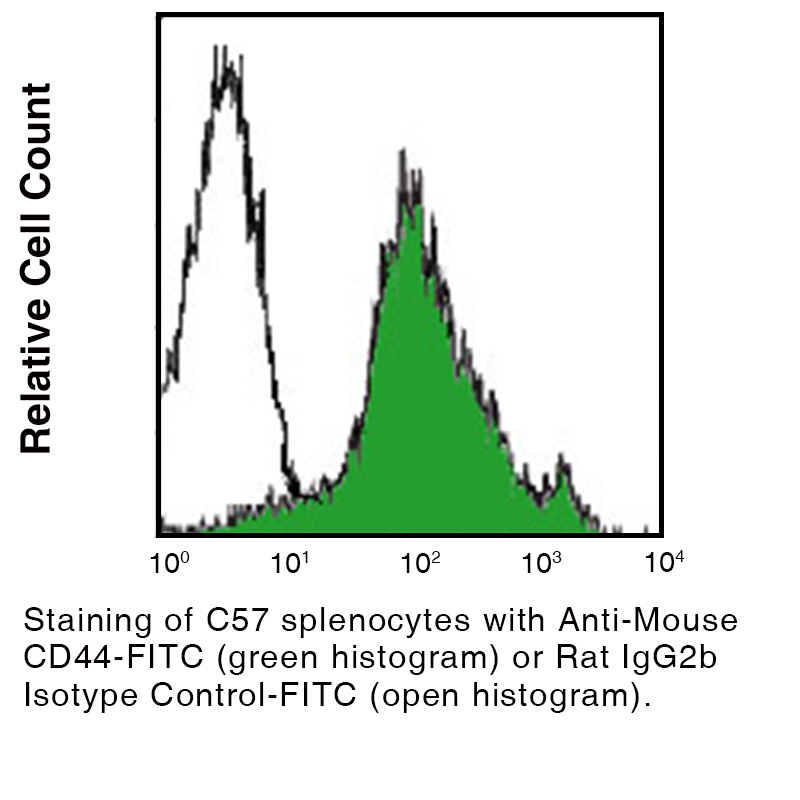Anti-Mouse/Human CD44 (Clone IM7) – PE
Anti-Mouse/Human CD44 (Clone IM7) – PE
Product No.: C254
- -
- -
Clone IM7 Target CD44 Formats AvailableView All Product Type Monoclonal Antibody Alternate Names Pgp-1, Ly-24, H-CAM Isotype IgG2b Applications FC |
Data
- -
- -
Antibody DetailsProduct DetailsReactive Species Human ⋅ Mouse Host Species Rat Product Concentration 0.2 mg/ml Formulation This R-phycoerythrin (R-PE) conjugate is formulated in 0.01 M phosphate buffered saline (150 mM NaCl) PBS pH 7.4, 1% BSA and 0.09% sodium azide as a preservative. Storage and Handling This R-PE conjugate is stable when stored at 2-8°C. Do not freeze. Country of Origin USA Shipping Next Day 2-8°C Excitation Laser Blue Laser (488 nm) and/or Green Laser (532 nm)/Yellow-Green Laser (561 nm) RRIDAB_2829552 Each investigator should determine their own optimal working dilution for specific applications. See directions on lot specific datasheets, as information may periodically change. DescriptionDescriptionSpecificity Clone IM7 recognizes an epitope common to alloantigens and all isoforms of CD44 that is located between amino acids 145 and 186. Background CD44 is an 80-95 kD glycoprotein that plays a role in various cellular functions including lymphocyte activation, recirculation and homing, hematopoiesis, and tumor metastasis. CD44 interacts with osteopontin, collagens, and matrix metalloproteinases (MMPs) and is a receptor for hyaluronic acid. Transcripts for this gene go through intricate alternative splicing that result in a variety of functionally distinct isoforms, including those which may be related to tumor metastasis. These splice variants of CD44 function as receptors under hemodynamic flow conditions that are significant to the development of cancer metastasis. Hence, it is thought that anti-CD44 tumor-specific mAbs may have therapeutic potential. This therapeutic potential of anti-CD44 mAbs is evident in some animal experiments demonstrating a reduction in malignant activities of various neoplasms when CD44 was targeted by a combination of mAbs, antisense oligonucleotides, and CD44-soluble proteins. It has been reported that high levels of CD44 on leukemic cells fuel leukemia production. Notably, various cancer studies show conflicting results pertaining to level of CD44 expression and its correlation with disease prognosis. Before anti-CD44 therapy can be applied to human cancers, it is essential to resolve this inconsistency. Antigen Distribution CD44 is expressed on all leukocytes, endothelial cells, hepatocytes, and mesenchymal cells in addition to B-cells, monocytes, macrophages and certain subsets of thymocytes and peripheral T-cells. Mice with the Ly-24.1 allotype have high densities of CD44+ T-cells. Ligand/Receptor Hyaluronan, MIP-1β, fibronectin, collagen PubMed NCBI Gene Bank ID UniProt.org Research Area Cell Adhesion . Cell Biology . Immunology . Stem Cell References & Citations1. Trowbridge, I. et al. (1982) Immunogenetics 15:299
2. Lesley, J. et al. (1988) Cell Immunol. 112:40 Technical ProtocolsCertificate of Analysis |
Related Products
- -
- -
Prod No. | Description |
|---|---|
C1804 | |
C1894 | |
C1800 | |
C1802 | |
C1886 | |
C1887 | |
C1888 | |
C1890 | |
C1892 | |
C2368 |
Formats Available
- -
- -
Prod No. | Description |
|---|---|
C1894 | |
C349 | |
C251 | |
C252 | |
C253 | |
C254 | |
C1886 | |
C1887 | |
C1888 | |
C1890 | |
C1892 | |
C501 | |
C382 | |
C2368 |



